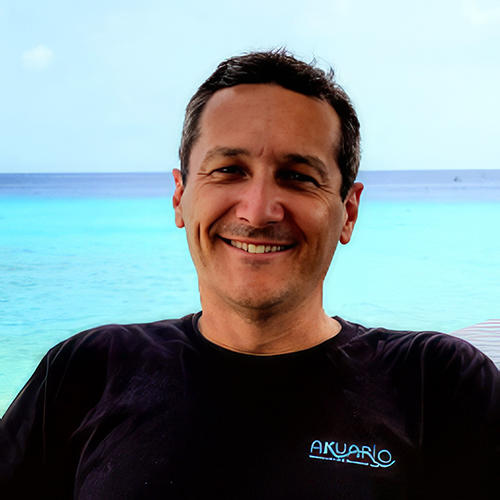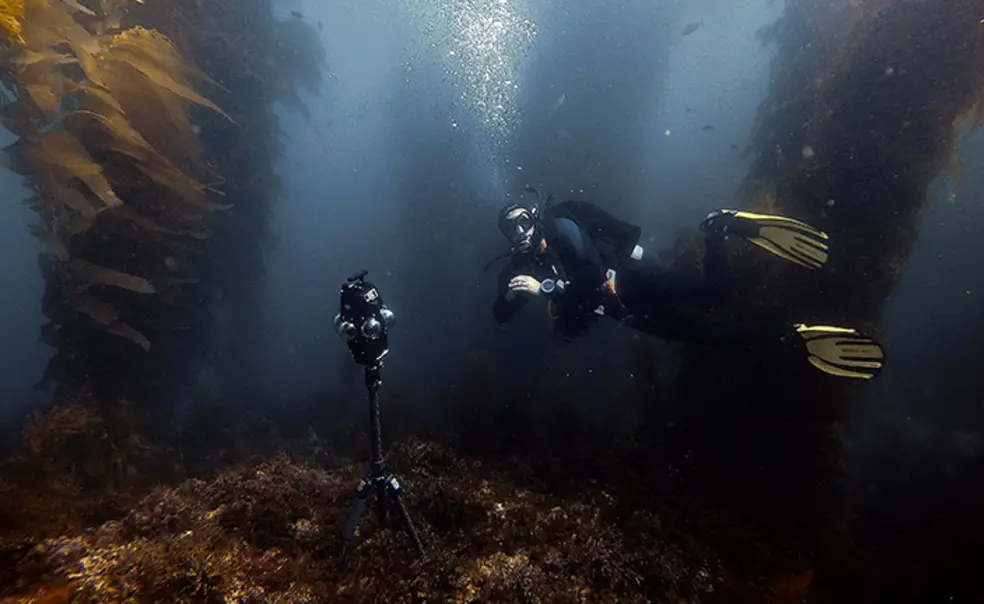Inside a Dome, Mark Davidson *08’s Film Immerses Viewers in the Ocean
Davidson harnessed new technology to film 360 degrees underwater and further ocean education
For as long as Mark Davidson *08 remembers, he has been fascinated with the ocean. “One of my earliest memories is just wading through the rock pools at the coastline and seeing what I could find — the crabs, the small little mudskipper fish jumping about, the urchins, the little starfish, anemones, those kinds of things,” Davidson says. When Davidson began developing his skills as a swimmer, soon followed by snorkeling and scuba diving, he realized “the first glimpses beneath the surface were just mind-blowing.”

Now, Davidson has striven to share that curiosity about the ocean through a novel concept — an unusual dome-shaped cinema resembling a small planetarium. Inside of Immersed: Ocean Wonders, located on Catalina Island, California, visitors watch a half-hour, 360º-film pulled from Davidson’s own scuba diving footage taken around the world (as well as film sourced from other divers), including from the waters near Bonaire in the Caribbean and the Indian Ocean off the Maldives. The film features glimpses of dolphins, whale sharks, and Catalina’s own kelp forests.
The dome is the first of many that Davidson plans to exhibit through a company he created, Akuario, aimed at furthering ocean education.
Born in South Africa, Davidson found his way to Princeton after studying microbiology at the University of Witwatersrand in Johannesburg, where he met Tullis Onstott *81, a Princeton professor of geosciences who was studying ultra-deep mines in South Africa to search for life in extreme environments analogous to conditions on other planets. Onstott invited Davidson to apply to Princeton for his Ph.D. in microbiology.
In 2002, Davidson arrived, and while serving as “bar czar” — a bartender at the Graduate College’s DBar — Davidson met his future wife, fellow bartender Agatha Lenartowicz *08, who was studying for her Ph.D. in psychology, as well as one of his best friends (and fellow DJ) David Stevens *06, a graduate student in the politics department.
In 2018, Davidson decided to pivot from his career as a scientific consultant and return to his interest in the sea by establishing Akuario and recruiting Lenartowicz and Stevens as co-founders. After toying with a concept for a virtual reality experience, the COVID pandemic — which made people reluctant to share goggles — persuaded Davidson to rethink the project as a film experience. Taking advantage of newly available technology such as the Insta360 Pro 2 camera and Mantis Sub underwater case, Davidson took submarine footage of his own to fashion a 360º film to be projected into a domed cinema.
For a location, they chose the picturesque community of Catalina, an island 29 miles off the coast of Los Angeles. Davidson says that the journey across the water made Catalina perfect. “It’s very hard for most people to cross any body of water and not wonder what’s down there,” Davidson explains.
The project’s first film, Immersed: Ocean Wonders, tries to make the underwater world more accessible to viewers who might not have the means or the physical predisposition to dive. “The underwater world is fascinating because it’s so unreachable for most of us,” Lenartowicz explains, adding that diving “is not for everybody.”
For future dome films, Stevens is looking at various local marine environments. He’s from New York City and argues, for example, that many New Yorkers don’t always appreciate that they live in a seaside town. “There are so many people who don’t have access to their own marine history,” Stevens says.
For Davidson, the effort is rooted in a way to promote climate action indirectly, by instilling wonder in viewers. “We’re trying to get people to change their behaviors indirectly by making them realize what a gorgeous and wonderful environment it is,” Davidson says.












No responses yet